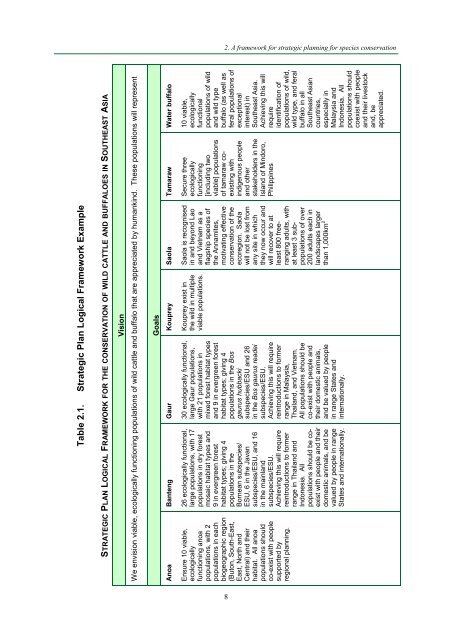Strategic Planning for Species Conservation: A Handbook - IUCN
Strategic Planning for Species Conservation: A Handbook - IUCN
Strategic Planning for Species Conservation: A Handbook - IUCN
You also want an ePaper? Increase the reach of your titles
YUMPU automatically turns print PDFs into web optimized ePapers that Google loves.
Table 2.1. <strong>Strategic</strong> Plan Logical Framework Example<br />
STRATEGIC PLAN LOGICAL FRAMEWORK FOR THE CONSERVATION OF WILD CATTLE AND BUFFALOES IN SOUTHEAST ASIA<br />
Vision<br />
We envision viable, ecologically functioning populations of wild cattle and buffalo that are appreciated by humankind. These populations will represent<br />
Goals<br />
Water buffalo<br />
Tamaraw<br />
Saola<br />
Kouprey<br />
Gaur<br />
Banteng<br />
Anoa<br />
2. A framework <strong>for</strong> strategic planning <strong>for</strong> species conservation<br />
10 viable,<br />
ecologically<br />
functional<br />
populations of wild<br />
and wild type<br />
buffalo (as well as<br />
feral populations of<br />
exceptional<br />
interest) in<br />
Southeast Asia.<br />
Achieving this will<br />
require<br />
identification of<br />
populations of wild,<br />
wild type, and feral<br />
buffalo in all<br />
Southeast Asian<br />
countries,<br />
especially in<br />
Malaysia and<br />
Indonesia. All<br />
populations should<br />
coexist with people<br />
and their livestock<br />
and, be<br />
appreciated.<br />
Secure three<br />
ecologically<br />
functioning<br />
[including two<br />
viable] populations<br />
of tamaraw coexisting<br />
with<br />
indigenous people<br />
and other<br />
stakeholders in the<br />
Island of Mindoro,<br />
Philippines<br />
Saola is recognised<br />
in and beyond Lao<br />
and Vietnam as a<br />
flagship species of<br />
the Annamites,<br />
motivating effective<br />
conservation of the<br />
ecoregion. Saola<br />
will not be lost from<br />
any site in which<br />
they now occur and<br />
will recover to at<br />
least 800 freeranging<br />
adults, with<br />
at least 3 subpopulations<br />
of over<br />
200 adults each in<br />
landscapes larger<br />
than 1,000km 2<br />
Kouprey exist in<br />
the wild in multiple<br />
viable populations.<br />
30 ecologically functional,<br />
large Gaur populations,<br />
with 21 populations in<br />
mixed <strong>for</strong>est habitat types<br />
and 9 in evergreen <strong>for</strong>est<br />
habitat types; giving 4<br />
populations in the Bos<br />
gaurus hubbacki<br />
subspecies/ESU and 26<br />
in the Bos gaurus readei<br />
subspecies/ESU.<br />
Achieving this will require<br />
reintroductions to <strong>for</strong>mer<br />
range in Malaysia,<br />
Thailand, and Vietnam.<br />
All populations should be<br />
co-exist with people and<br />
their domestic animals,<br />
and be valued by people<br />
in range States and<br />
internationally.<br />
26 ecologically functional,<br />
large populations, with 17<br />
populations in dry <strong>for</strong>est<br />
mosaic habitat types and<br />
9 in evergreen <strong>for</strong>est<br />
habitat types; giving 4<br />
populations in the<br />
Bornean subspecies/<br />
ESU, 6 in the Javan<br />
subspecies/ESU, and 16<br />
in the mainland<br />
subspecies/ESU.<br />
Achieving this will require<br />
reintroductions to <strong>for</strong>mer<br />
range in Thailand and<br />
Indonesia. All<br />
populations should be coexist<br />
with people and their<br />
domestic animals, and be<br />
valued by people in range<br />
States and internationally.<br />
Ensure 10 viable,<br />
ecologically<br />
functioning anoa<br />
populations, with 2<br />
populations in each<br />
biogeographic region<br />
(Buton, South-East,<br />
East, North and<br />
Central) and their<br />
habitat. All anoa<br />
populations should<br />
co-exist with people<br />
supported by<br />
regional planning.<br />
8

















